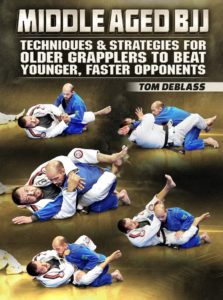When competing in BJJ past the age of 30, you have the option to enter some tournaments in the master divisions. For IBJJF tournaments, they have set up age divisions for the 30+ and over. Master 1 is for athletes aged 30 (or turning 30 on the same year as the competition) to 35 , Master 2 is for athletes aged 36 (including) to 40, Master 3 is from 41 to 44 and so on every 5 years.
Also read:
BJJ Competitions: How Are Masters Different From Adult Divisions?
A question we hear often is “How is a masters division different from regular, adult Division (18 to 29 yers of age)?”
#1 in the IBJJF master ranking, Juninho Boi (FFTeam), spoke to GRACIEMAG translate from Portuguese, about his adapted training, tips and tricks and the main difference between an adult black belt and a master black belt. Check out the best excerpts:
“I believe that the main difference is related to physical recovery. Today, at the age of 37, I realize how tired we get from one training session to the next, and how much longer it takes to recover from one fight to the next. Quite different from when we were younger, and muscle recovery happened so that we didn’t even feel it. And I know that, because I have fought matches against Marcus Buchecha, Rodolfo Vieira, Leandro Lo, Bêrnardo Faria, Serginho Moraes and so many other players, and now I’m competing in the master divisions. But the fight is still tough!”
What is your recipe for minimizing injuries in training and tournaments?
“I try to balance my routine between Jiu-Jitsu, weight training, cross-fit, physical therapy and various activities. For example, I like the slackline, walking that tightrope. Many other competitors opt for swimming too, for example. And, by the way, this combination has had an effect that I never had as a competitor, even in adults.
What is your routine to maximize your workout time, train, do physiotherapy and everything, so that everything works out well and you don’t wear out?
I try to do these workouts in an altered way. One day I do Jiu-Jitsu training and a weight training session. The other day, I train Jiu-Jitsu and do a cross-fit, and it goes from Monday to Saturday. I leave Sunday for varied activities like the slackline, to help with the stabilizing muscles and also to have fun.
The master fighter needs to focus on physical therapy, right? How do you see this prevention and recovery activity?
In the past, I did physiotherapy work in that standard mode – when I got hurt I went there and took care of my muscles with the specialized professionals. Nowadays, I changed the way I look at it, and I do preventive physiotherapy with the great Guilherme Panuncio, who besides being a great professional is my team’s brown belt, FFTeam in Bragança.
Did you get injured much?
During my career as an adult, I was hurt by lack of experience. It has been two years since I got hurt because of this new way of looking at my professional life, with preventive and professional monitoring. But I have my scars: two broken tendon triceps, a broken meniscus and other lighter ones.
If a 45 year old guy comes to your gym wanting to compete, what tips would you give him?
First, I believe that only those who have discipline win. I would start by making suggestions about proper nutrition, rest and supplementation. And I would tell him to keep in mind that we are no longer young, and we pay the price with age. From there, I would guide the student to train consciously, respect the body and not try to train like a 19-year-old boy when it comes to rolling.”
As Rickson Gracie said: “Jiu-Jitsu is for life.” Whether you like to compete or not, the most important is to be able to train and have fun.
Fight Smart And Win As An Older Grappler With Tom DeBlass’s Guide To Beating Younger, Faster Opponents With These Key Details And Fundamental Brazilian Jiu-Jitsu Concepts To Slowing The Fight Down And Keeping Control.
- Learn how an older grappler can use real technique and useful technique to simplify their Brazilian jiu-jitsu and slow down younger grapplers with Tom DeBlass’s help.
- Tom DeBlass is a UFC veteran fighter and a respected black belt grappling coach in Brazilian jiu-jitsu, as well as a BJJ Fanatics favorite.
- Tom shows how to work from top and bottom position with techniques and attacks that older grapplers can gain advantage with, including half guard, pressure passing, and more.
The post Should Older Jiu-Jitsu Competitors Be Training Like Younger Competitors? appeared first on Bjj Eastern Europe.

